Input interpretation

H_2O water + KI potassium iodide + O_3 ozone ⟶ KOH potassium hydroxide + I_2 iodine
Balanced equation
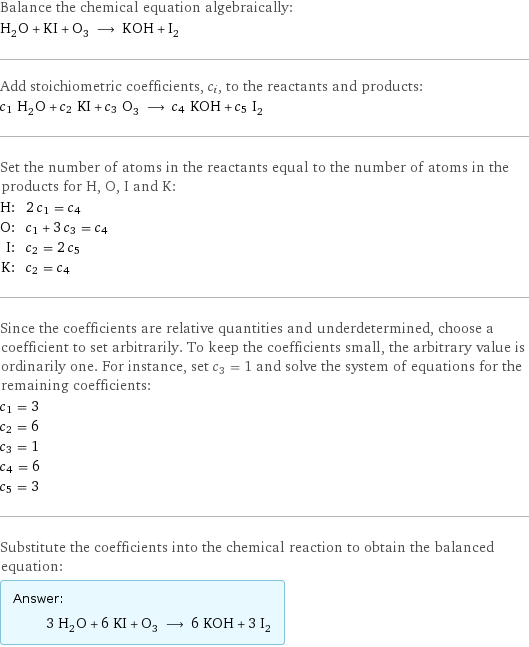
Balance the chemical equation algebraically: H_2O + KI + O_3 ⟶ KOH + I_2 Add stoichiometric coefficients, c_i, to the reactants and products: c_1 H_2O + c_2 KI + c_3 O_3 ⟶ c_4 KOH + c_5 I_2 Set the number of atoms in the reactants equal to the number of atoms in the products for H, O, I and K: H: | 2 c_1 = c_4 O: | c_1 + 3 c_3 = c_4 I: | c_2 = 2 c_5 K: | c_2 = c_4 Since the coefficients are relative quantities and underdetermined, choose a coefficient to set arbitrarily. To keep the coefficients small, the arbitrary value is ordinarily one. For instance, set c_3 = 1 and solve the system of equations for the remaining coefficients: c_1 = 3 c_2 = 6 c_3 = 1 c_4 = 6 c_5 = 3 Substitute the coefficients into the chemical reaction to obtain the balanced equation: Answer: | | 3 H_2O + 6 KI + O_3 ⟶ 6 KOH + 3 I_2
Structures

+ + ⟶ +
Names

water + potassium iodide + ozone ⟶ potassium hydroxide + iodine
Reaction thermodynamics
Enthalpy
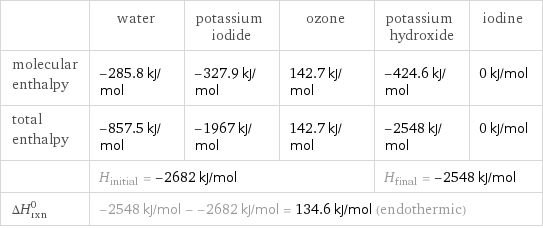
| water | potassium iodide | ozone | potassium hydroxide | iodine molecular enthalpy | -285.8 kJ/mol | -327.9 kJ/mol | 142.7 kJ/mol | -424.6 kJ/mol | 0 kJ/mol total enthalpy | -857.5 kJ/mol | -1967 kJ/mol | 142.7 kJ/mol | -2548 kJ/mol | 0 kJ/mol | H_initial = -2682 kJ/mol | | | H_final = -2548 kJ/mol | ΔH_rxn^0 | -2548 kJ/mol - -2682 kJ/mol = 134.6 kJ/mol (endothermic) | | | |
Gibbs free energy
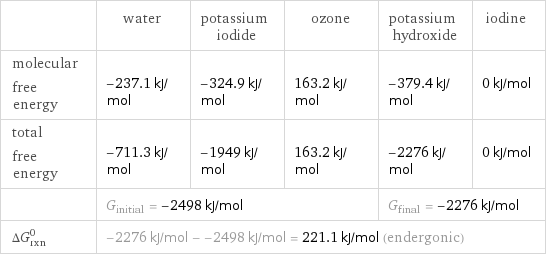
| water | potassium iodide | ozone | potassium hydroxide | iodine molecular free energy | -237.1 kJ/mol | -324.9 kJ/mol | 163.2 kJ/mol | -379.4 kJ/mol | 0 kJ/mol total free energy | -711.3 kJ/mol | -1949 kJ/mol | 163.2 kJ/mol | -2276 kJ/mol | 0 kJ/mol | G_initial = -2498 kJ/mol | | | G_final = -2276 kJ/mol | ΔG_rxn^0 | -2276 kJ/mol - -2498 kJ/mol = 221.1 kJ/mol (endergonic) | | | |
Equilibrium constant
![Construct the equilibrium constant, K, expression for: H_2O + KI + O_3 ⟶ KOH + I_2 Plan: • Balance the chemical equation. • Determine the stoichiometric numbers. • Assemble the activity expression for each chemical species. • Use the activity expressions to build the equilibrium constant expression. Write the balanced chemical equation: 3 H_2O + 6 KI + O_3 ⟶ 6 KOH + 3 I_2 Assign stoichiometric numbers, ν_i, using the stoichiometric coefficients, c_i, from the balanced chemical equation in the following manner: ν_i = -c_i for reactants and ν_i = c_i for products: chemical species | c_i | ν_i H_2O | 3 | -3 KI | 6 | -6 O_3 | 1 | -1 KOH | 6 | 6 I_2 | 3 | 3 Assemble the activity expressions accounting for the state of matter and ν_i: chemical species | c_i | ν_i | activity expression H_2O | 3 | -3 | ([H2O])^(-3) KI | 6 | -6 | ([KI])^(-6) O_3 | 1 | -1 | ([O3])^(-1) KOH | 6 | 6 | ([KOH])^6 I_2 | 3 | 3 | ([I2])^3 The equilibrium constant symbol in the concentration basis is: K_c Mulitply the activity expressions to arrive at the K_c expression: Answer: | | K_c = ([H2O])^(-3) ([KI])^(-6) ([O3])^(-1) ([KOH])^6 ([I2])^3 = (([KOH])^6 ([I2])^3)/(([H2O])^3 ([KI])^6 [O3])](../image_source/c36475c8a1e405c8bcbc7cbeda1561d9.png)
Construct the equilibrium constant, K, expression for: H_2O + KI + O_3 ⟶ KOH + I_2 Plan: • Balance the chemical equation. • Determine the stoichiometric numbers. • Assemble the activity expression for each chemical species. • Use the activity expressions to build the equilibrium constant expression. Write the balanced chemical equation: 3 H_2O + 6 KI + O_3 ⟶ 6 KOH + 3 I_2 Assign stoichiometric numbers, ν_i, using the stoichiometric coefficients, c_i, from the balanced chemical equation in the following manner: ν_i = -c_i for reactants and ν_i = c_i for products: chemical species | c_i | ν_i H_2O | 3 | -3 KI | 6 | -6 O_3 | 1 | -1 KOH | 6 | 6 I_2 | 3 | 3 Assemble the activity expressions accounting for the state of matter and ν_i: chemical species | c_i | ν_i | activity expression H_2O | 3 | -3 | ([H2O])^(-3) KI | 6 | -6 | ([KI])^(-6) O_3 | 1 | -1 | ([O3])^(-1) KOH | 6 | 6 | ([KOH])^6 I_2 | 3 | 3 | ([I2])^3 The equilibrium constant symbol in the concentration basis is: K_c Mulitply the activity expressions to arrive at the K_c expression: Answer: | | K_c = ([H2O])^(-3) ([KI])^(-6) ([O3])^(-1) ([KOH])^6 ([I2])^3 = (([KOH])^6 ([I2])^3)/(([H2O])^3 ([KI])^6 [O3])
Rate of reaction
![Construct the rate of reaction expression for: H_2O + KI + O_3 ⟶ KOH + I_2 Plan: • Balance the chemical equation. • Determine the stoichiometric numbers. • Assemble the rate term for each chemical species. • Write the rate of reaction expression. Write the balanced chemical equation: 3 H_2O + 6 KI + O_3 ⟶ 6 KOH + 3 I_2 Assign stoichiometric numbers, ν_i, using the stoichiometric coefficients, c_i, from the balanced chemical equation in the following manner: ν_i = -c_i for reactants and ν_i = c_i for products: chemical species | c_i | ν_i H_2O | 3 | -3 KI | 6 | -6 O_3 | 1 | -1 KOH | 6 | 6 I_2 | 3 | 3 The rate term for each chemical species, B_i, is 1/ν_i(Δ[B_i])/(Δt) where [B_i] is the amount concentration and t is time: chemical species | c_i | ν_i | rate term H_2O | 3 | -3 | -1/3 (Δ[H2O])/(Δt) KI | 6 | -6 | -1/6 (Δ[KI])/(Δt) O_3 | 1 | -1 | -(Δ[O3])/(Δt) KOH | 6 | 6 | 1/6 (Δ[KOH])/(Δt) I_2 | 3 | 3 | 1/3 (Δ[I2])/(Δt) (for infinitesimal rate of change, replace Δ with d) Set the rate terms equal to each other to arrive at the rate expression: Answer: | | rate = -1/3 (Δ[H2O])/(Δt) = -1/6 (Δ[KI])/(Δt) = -(Δ[O3])/(Δt) = 1/6 (Δ[KOH])/(Δt) = 1/3 (Δ[I2])/(Δt) (assuming constant volume and no accumulation of intermediates or side products)](../image_source/d854d4af128001f41e1cc14649488a9b.png)
Construct the rate of reaction expression for: H_2O + KI + O_3 ⟶ KOH + I_2 Plan: • Balance the chemical equation. • Determine the stoichiometric numbers. • Assemble the rate term for each chemical species. • Write the rate of reaction expression. Write the balanced chemical equation: 3 H_2O + 6 KI + O_3 ⟶ 6 KOH + 3 I_2 Assign stoichiometric numbers, ν_i, using the stoichiometric coefficients, c_i, from the balanced chemical equation in the following manner: ν_i = -c_i for reactants and ν_i = c_i for products: chemical species | c_i | ν_i H_2O | 3 | -3 KI | 6 | -6 O_3 | 1 | -1 KOH | 6 | 6 I_2 | 3 | 3 The rate term for each chemical species, B_i, is 1/ν_i(Δ[B_i])/(Δt) where [B_i] is the amount concentration and t is time: chemical species | c_i | ν_i | rate term H_2O | 3 | -3 | -1/3 (Δ[H2O])/(Δt) KI | 6 | -6 | -1/6 (Δ[KI])/(Δt) O_3 | 1 | -1 | -(Δ[O3])/(Δt) KOH | 6 | 6 | 1/6 (Δ[KOH])/(Δt) I_2 | 3 | 3 | 1/3 (Δ[I2])/(Δt) (for infinitesimal rate of change, replace Δ with d) Set the rate terms equal to each other to arrive at the rate expression: Answer: | | rate = -1/3 (Δ[H2O])/(Δt) = -1/6 (Δ[KI])/(Δt) = -(Δ[O3])/(Δt) = 1/6 (Δ[KOH])/(Δt) = 1/3 (Δ[I2])/(Δt) (assuming constant volume and no accumulation of intermediates or side products)
Chemical names and formulas
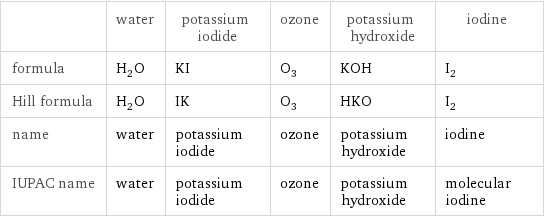
| water | potassium iodide | ozone | potassium hydroxide | iodine formula | H_2O | KI | O_3 | KOH | I_2 Hill formula | H_2O | IK | O_3 | HKO | I_2 name | water | potassium iodide | ozone | potassium hydroxide | iodine IUPAC name | water | potassium iodide | ozone | potassium hydroxide | molecular iodine
Substance properties
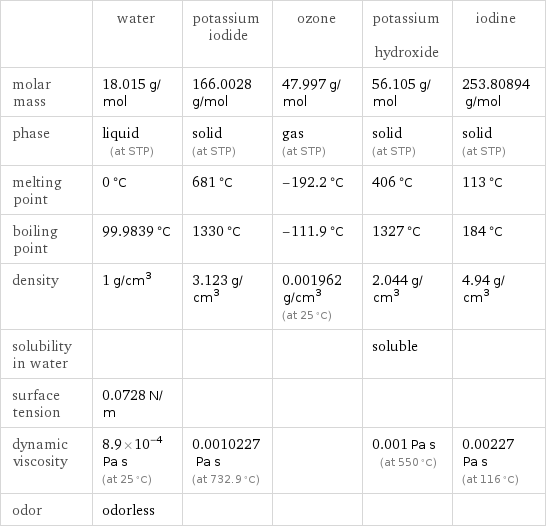
| water | potassium iodide | ozone | potassium hydroxide | iodine molar mass | 18.015 g/mol | 166.0028 g/mol | 47.997 g/mol | 56.105 g/mol | 253.80894 g/mol phase | liquid (at STP) | solid (at STP) | gas (at STP) | solid (at STP) | solid (at STP) melting point | 0 °C | 681 °C | -192.2 °C | 406 °C | 113 °C boiling point | 99.9839 °C | 1330 °C | -111.9 °C | 1327 °C | 184 °C density | 1 g/cm^3 | 3.123 g/cm^3 | 0.001962 g/cm^3 (at 25 °C) | 2.044 g/cm^3 | 4.94 g/cm^3 solubility in water | | | | soluble | surface tension | 0.0728 N/m | | | | dynamic viscosity | 8.9×10^-4 Pa s (at 25 °C) | 0.0010227 Pa s (at 732.9 °C) | | 0.001 Pa s (at 550 °C) | 0.00227 Pa s (at 116 °C) odor | odorless | | | |
Units
